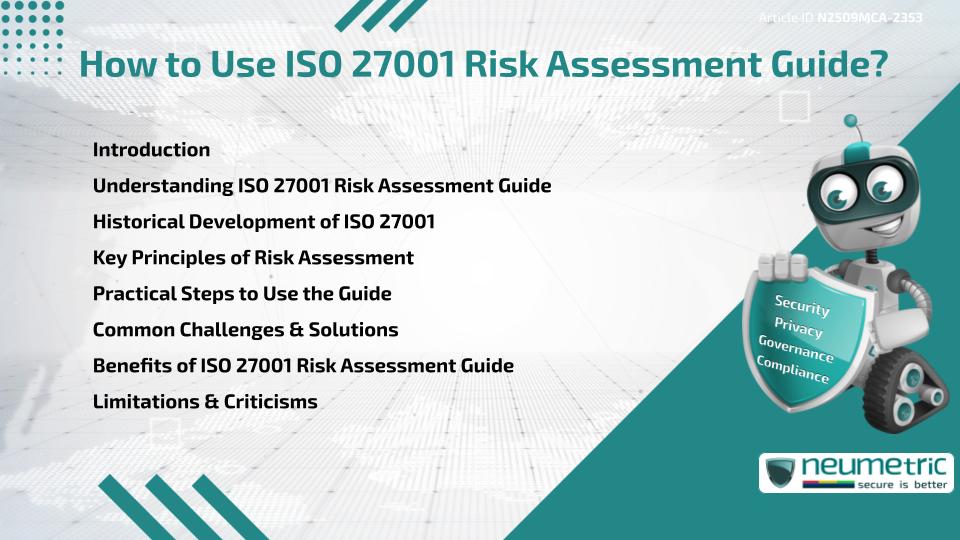Table of Contents
ToggleIntroduction
The ISO 27001 Risk Assessment Guide helps Organisations identify, evaluate & mitigate Information Security Risks systematically. Using this guide ensures businesses protect Sensitive Data, maintain Compliance & build Resilience against evolving Threats. This article explains the fundamentals of the ISO 27001 Risk Assessment Guide, its background, key principles, steps for effective use, challenges, benefits & limitations.
Understanding ISO 27001 Risk Assessment Guide
The ISO 27001 Risk Assessment Guide provides structured methods to analyse Risks associated with Information assets. It involves identifying Potential Threats, evaluating Vulnerabilities & assigning Risk levels to prioritise mitigation. The guide is central to the Information Security Management System [ISMS] & ensures Organisations make informed decisions about controls.
Historical Development of ISO 27001
ISO 27001 emerged from the British Standard BS 7799 & became an International Standard in 2005. Since then, it has been updated to reflect modern cyber Risks & Regulatory demands. The Risk Assessment Guide evolved alongside these updates to provide clearer frameworks for identifying & addressing Threats in diverse Organisations.
Key Principles of Risk Assessment
The ISO 27001 Risk Assessment Guide rests on Core Principles:
- Confidentiality, Integrity & Availability of data
- Systematic identification of Threats & Vulnerabilities
- Risk prioritisation based on Likelihood & Impact
- Continuous Improvement through Monitoring & Review
These principles ensure that security efforts are consistent, measurable & aligned with organisational objectives.
Practical Steps to Use the Guide
Organisations can apply the ISO 27001 Risk Assessment Guide through the following steps:
- Define the scope of Assessment & assets involved
- Identify Threats & Vulnerabilities to each asset
- Evaluate Risks using a Risk matrix or scoring method
- Develop a Risk Treatment plan with suitable Controls
- Document results & Review Assessments regularly
Practical application requires teamwork between IT, management & Employees to ensure all perspectives are considered.
Common Challenges & Solutions
Challenges include lack of expertise, limited resources & difficulty in quantifying Risks. Some Organisations also struggle with integrating the guide into daily operations. Solutions involve providing staff training, adopting simplified Risk methodologies & using automated tools for Assessment & Monitoring.
Benefits of ISO 27001 Risk Assessment Guide
Key benefits include:
- Clear visibility into Potential Threats
- Better resource allocation for Security efforts
- Stronger Compliance with Legal & Contractual requirements
- Reduced Likelihood of Data Breaches
- Increased Stakeholder Confidence
By embedding the guide into daily processes, Organisations can foster a proactive security culture.
Limitations & Criticisms
Some critics argue that the ISO 27001 Risk Assessment Guide can be resource-heavy & overly complex for Small Businesses. Others point out that Risk scoring can sometimes be subjective. A balanced approach involves tailoring the guide to the organisation’s size & context while maintaining consistency.
Conclusion
The ISO 27001 Risk Assessment Guide is an essential tool for managing Information Security Risks effectively. Despite challenges, its structured Framework provides lasting benefits for Organisations seeking to strengthen their security posture.
Takeaways
- The ISO 27001 Risk Assessment Guide helps identify & manage security Risks.
- It is based on principles of Confidentiality, Integrity & Availability.
- Practical steps include Defining Scope, identifying Threats & creating Treatment Plans.
- Challenges can be mitigated with training & automation.
- Benefits include Compliance, reduced Risks & greater Trust.
FAQ
What is the ISO 27001 Risk Assessment Guide?
It is a structured Framework for identifying, evaluating & treating Information Security Risks within an ISMS.
Why is the ISO 27001 Risk Assessment Guide important?
It ensures Organisations manage Risks proactively, protect data & comply with regulations.
Who should use the ISO 27001 Risk Assessment Guide?
Any organisation handling sensitive or regulated information benefits from applying the guide.
How do you conduct a Risk Assessment using the guide?
By Defining Scope, identifying Threats & Vulnerabilities, evaluating Risks & developing Treatment Plans.
What challenges exist in applying the guide?
Common challenges include resource limitations, lack of expertise & complexity in implementation.
Is Certification available for ISO 27001 Risk Assessment Guide?
No, certification is for ISO 27001, but the Risk Assessment guide is a core requirement of that Certification.
How often should a Risk Assessment be performed?
At least annually or whenever significant changes in Systems, Processes or Threats occur.
Is using the ISO 27001 Risk Assessment Guide mandatory?
It is not legally mandatory but is essential for ISO 27001 Certification & often required in Contracts.
Need help for Security, Privacy, Governance & VAPT?
Neumetric provides organisations the necessary help to achieve their Cybersecurity, Compliance, Governance, Privacy, Certifications & Pentesting needs.
Organisations & Businesses, specifically those which provide SaaS & AI Solutions in the Fintech, BFSI & other regulated sectors, usually need a Cybersecurity Partner for meeting & maintaining the ongoing Security & Privacy needs & requirements of their Enterprise Clients & Privacy conscious Customers.
SOC 2, ISO 27001, ISO 42001, NIST, HIPAA, HECVAT, EU GDPR are some of the Frameworks that are served by Fusion – a SaaS, multimodular, multitenant, centralised, automated, Cybersecurity & Compliance Management system.
Neumetric also provides Expert Services for technical security which covers VAPT for Web Applications, APIs, iOS & Android Mobile Apps, Security Testing for AWS & other Cloud Environments & Cloud Infrastructure & other similar scopes.
Reach out to us by Email or filling out the Contact Form…


